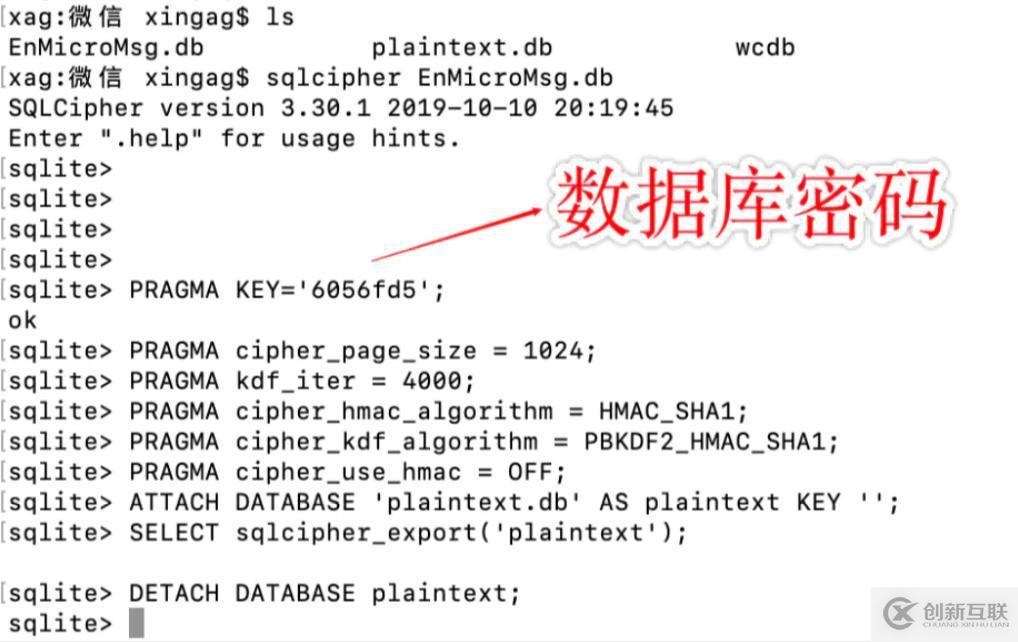用Python來(lái)分析微信群聊的案例-創(chuàng)新互聯(lián)
創(chuàng)新互聯(lián)www.cdcxhl.cn八線動(dòng)態(tài)BGP香港云服務(wù)器提供商,新人活動(dòng)買多久送多久,劃算不套路!

這篇文章將為大家詳細(xì)講解有關(guān)用Python來(lái)分析微信群聊的案例,小編覺(jué)得挺實(shí)用的,因此分享給大家做個(gè)參考,希望大家閱讀完這篇文章后可以有所收獲。
1. 場(chǎng)景
前幾天,有一位小伙伴在后臺(tái)給我留言,說(shuō)自己有幾十個(gè)微信群,自己精力有限,沒(méi)法看過(guò)來(lái),想要篩選一些高質(zhì)量的群,讓我是否能幫忙想想辦法。
其實(shí),微信群里的所有聊天記錄都在手機(jī)本地文件夾內(nèi),只需要導(dǎo)出來(lái)進(jìn)行解密,然后來(lái)一波數(shù)據(jù)分析,就可以幫他篩選出高質(zhì)量的社群。
本篇文章將帶大家用 Python 一步步來(lái)實(shí)現(xiàn)這個(gè)功能。
2. 實(shí)現(xiàn)步驟
第 1 步,導(dǎo)出微信聊天記錄數(shù)據(jù)庫(kù)
首先,我們使用一部 Root 后的手機(jī)或者模擬器登錄微信,找到微信聊天記錄數(shù)據(jù)庫(kù),然后導(dǎo)出到本地。
數(shù)據(jù)庫(kù)文件的完整路徑如下:
# 微信聊天記錄數(shù)據(jù)庫(kù)完整路徑 /data/data/com.tencent.mm/MicroMsg/[當(dāng)前登錄微信的隨機(jī)字符串]/EnMicroMsg.db
需要注意的是,如果當(dāng)前設(shè)備沒(méi)有 Root,可以選擇群聊消息進(jìn)行一次遷移,然后從 Root 設(shè)備或模擬器中導(dǎo)出數(shù)據(jù)庫(kù)。
第 2 步,獲取數(shù)據(jù)庫(kù)的密碼
微信數(shù)據(jù)庫(kù)的密碼組成形式為:手機(jī) IMEI + 微信 UIN,然后 md5 加密(32 位小寫)的前 7 個(gè)數(shù)字。
其中,手機(jī)的 IMEI 可以通過(guò) *#06# 獲取,如果是雙卡手機(jī),需要自己做一下判斷。

微信的 UIN 在下面配置文件中,找到 name 屬性為 default_uin 的 value 值,即為 UIN
# 當(dāng)前登錄微信的配置文件 /data/data/com.tencent.mm/shared_prefs/system_config_prefs.xml
最后,然后將 IMET 和 UIN 組成字符串,然后利用 MD5 進(jìn)行加密,取 32 位小寫的前 7 位即為微信數(shù)據(jù)庫(kù)的密碼。

第 3 步,破解數(shù)據(jù)庫(kù)
由于微信數(shù)據(jù)庫(kù)是使用 SQLCipher 生成,所以要先安裝 sqlcipher 命令行文件
# 安裝sqlcipher命令行(Mac) brew install sqlcipher # Win可以去下載sqlcipher命令行文件
然后,輸入數(shù)據(jù)庫(kù)的密碼及解密方式等,導(dǎo)出破解后的數(shù)據(jù)庫(kù)。

第 4 步,分析數(shù)據(jù)庫(kù)
推薦使用 SQLiteSutdio 打開(kāi)并分析上面破解后的數(shù)據(jù)庫(kù),重點(diǎn)查看 message、rcontact、chatroom 這 3 張表。
微信所有的文字聊天記錄都存放在 mesage 數(shù)據(jù)表中,包含:聊天內(nèi)容、發(fā)送者、消息類型、創(chuàng)建時(shí)間等

rcontact 為微信通訊錄表,包含:微信 ID、昵稱、備注名等
chatroom 是群聊信息表,包含:群聊 ID、成員列表等
第 5 步,Python 打開(kāi)數(shù)據(jù)庫(kù)并封裝
使用 sqlite3連接本地?cái)?shù)據(jù)庫(kù)文件,獲取數(shù)據(jù)庫(kù)對(duì)象和游標(biāo)對(duì)象
import sqlite3 def __init__(self, db_path="./weixin.db"): """ 本地?cái)?shù)據(jù)庫(kù)初始化 """ self.db = sqlite3.connect(db_path) self.cursor = self.db.cursor()
接著,對(duì)數(shù)據(jù)庫(kù)常用的操作,包含:增刪改查,進(jìn)行封裝操作。
def execute(self, sql, param=None): """ sql: Sql語(yǔ)句,包含:增、刪、改 param:數(shù)據(jù),可以為列表、字典,也可以為空 """ try: if param is None: self.cursor.execute(sql) else: if type(param) is list: self.cursor.executemany(sql, param) else: self.cursor.execute(sql, param) count = self.db.total_changes self.db.commit() except Exception as e: print(e) return False, e # 返回結(jié)果 return True if count > 0 else False def query(self, sql, param=None): """ 查詢語(yǔ)句 sql:Sql語(yǔ)句 param:參數(shù),可以包含空 retutn:成功返回True """ if param is None: self.cursor.execute(sql) else: self.cursor.execute(sql, param) # 返回查詢的結(jié)果 return self.cursor.fetchall()
第 6 步,通過(guò)群聊名稱獲取群聊 ID
根據(jù)群聊昵稱,使用 Sql 語(yǔ)句查詢 rcontact 表,可以獲取群聊的 ID 值
def __get_chartroom_id(self):
"""
獲取群聊的id
:return:
"""
res = self.db.query('select username from rcontact where nickname=?;', (self.chatroom_name,))
# 群聊id
chatroom_id = res[0][0]
return chatroom_id第 7 步,獲取群聊消息
擁有群聊 ID 之后,緊接著查詢 message 表,獲取當(dāng)前群聊的所有消息內(nèi)容。
# message表:聊天記錄表
# isSend=0:對(duì)方發(fā)送的;isSend=1:自己發(fā)送的
sql = "SELECT content FROM message WHERE talker='{}' and isSend=0".format(chatroom_id)
# 查詢表,獲取所有的聊天記錄
result = self.db.query(sql)為了獲取有效的消息內(nèi)容,可以清洗掉自己發(fā)送的消息、系統(tǒng)消息、紅包消息等內(nèi)容
# 循環(huán)查詢到的所有的消息
for item in result:
# 過(guò)濾數(shù)據(jù)
if not item or not item[0] or item[0].find('xml') != -1 or item[0].find('sysmsg') != -1 or item[0].find(
'<msg>') != -1 or item[0].find('chatroom') != -1 or item[0].find('weixinhongbao') != -1:
continue
# 過(guò)濾掉自己發(fā)送的內(nèi)容,不包含:
temps = item[0].split(':')
if len(temps) < 2:
# print('自己發(fā)送的內(nèi)容:' + item[0])
continue
# 每一條聊天記錄,過(guò)濾掉發(fā)送者,只保留消息正文
# 發(fā)送者
send_from = item[0].split(':')[0]
# 發(fā)送內(nèi)容
send_msg = "".join(item[0].split(':')[1:]).strip().replace("\"", "")
# 過(guò)長(zhǎng)的消息,也過(guò)濾掉
if len(send_msg) > 200:
continue對(duì)于群其他成員發(fā)送的內(nèi)容,再過(guò)濾掉消息內(nèi)容的前半部分,只保留消息正文

第 8 步,生成詞云
使用 jieba 對(duì)群內(nèi)有效的消息進(jìn)行分詞,然后使用 wordcloud 生成詞云圖。
def generate_wordcloud(self, word):
"""
生成詞云
:param word:
:return:
"""
img = WordCloud(font_path="./DroidSansFallbackFull.ttf", width=2000, height=2000,
margin=2, collocations=False).generate(word)
plt.imshow(img)
plt.axis("off")
plt.show()
# 保存圖片
img.to_file("{}.png".format("群聊"))
# 分詞
temp = " ".join(jieba.cut(words, cut_all=True))
# 生成詞云
generate_wordcloud(temp)第 9 步,新建排名表,插入數(shù)據(jù)
為了統(tǒng)計(jì)群聊活躍度排名,我們需要新建一張表,包含:id、微信昵稱、消息內(nèi)容 3 個(gè)字段。
def __create_top_table(self): """ 創(chuàng)建Top表 :return: """ # 創(chuàng)建Top表,如果存在就不重新創(chuàng)建 result = self.db.execute( "CREATE TABLE IF NOT EXISTS top(uid integer primary key,name varchar(200),msg varchar(200))")
接著,將上一步的每一條消息中的發(fā)送者 ID、發(fā)送內(nèi)容 2 個(gè)字段插入到新建的 Top 表內(nèi)
# 定義一個(gè)列表,加入所有要統(tǒng)計(jì)的數(shù)據(jù)
msg_pre = []
for item in result:
# 發(fā)送者
send_from = item[0].split(':')[0]
# 發(fā)送內(nèi)容
send_msg = "".join(item[0].split(':')[1:]).strip().replace("\"", "")
msg_pre.append((send_from, send_msg))
# 把要統(tǒng)計(jì)的數(shù)據(jù),插入到top表中
self.db.execute("insert into top(uid,name,msg) values (NULL,?,?);", msg_pre)第 10 步,獲取活躍度排名并可視化
從 Top 數(shù)據(jù)表中,通過(guò)微信昵稱查詢出每一位成員發(fā)言的次數(shù),并保存到一個(gè)列表中
def get_top_partner(self):
"""
排名前15的成員
:return:
"""
sql = "SELECT name as 姓名,COUNT(*) as times FROM top GROUP BY name ORDER BY times DESC limit %d;" % self.top_num
result = self.db.query(sql)
for item in result:
# 用戶id
id = item[0]
# 發(fā)言次數(shù)
count = item[1]
# 獲取用戶的昵稱,即:微信昵稱
username = self.get_username(id)
self.top_data.append({
'username': username,
'count': count
})最后,去除微信昵稱的特殊符號(hào),使用 pyecharts 將數(shù)據(jù)可視化。
def draw_image(self):
"""
數(shù)據(jù)可視化
:return:
"""
usernames = []
counts = []
for user in self.top_data:
# 去除昵稱中的特殊符號(hào)
usernames.append(get_ava_string(user.get('username').strip())[0:8])
counts.append(user.get('count'))
def bar_chart() -> Bar:
c = (
Bar()
.add_xaxis(usernames)
.add_yaxis("活躍度", counts)
.reversal_axis()
.set_series_opts(label_opts=opts.LabelOpts(position="right"))
.set_global_opts(title_opts=opts.TitleOpts(title="最活躍的%d個(gè)小伙伴" % self.top_num))
)
return c
# 需要安裝 snapshot-selenium 或者 snapshot-phantomjs
make_snapshot(driver, bar_chart().render(), "bar.png")3. 最后
上面的操作,通過(guò)生成的詞云了解到當(dāng)前群聊過(guò)去一段時(shí)間都在聊的話題及價(jià)值,通過(guò)對(duì)聊天記錄的數(shù)據(jù)分析,獲取到微信群聊活躍度排名。

關(guān)于用Python來(lái)分析微信群聊的案例就分享到這里了,希望以上內(nèi)容可以對(duì)大家有一定的幫助,可以學(xué)到更多知識(shí)。如果覺(jué)得文章不錯(cuò),可以把它分享出去讓更多的人看到。
網(wǎng)站標(biāo)題:用Python來(lái)分析微信群聊的案例-創(chuàng)新互聯(lián)
鏈接地址:http://chinadenli.net/article8/gdgop.html
成都網(wǎng)站建設(shè)公司_創(chuàng)新互聯(lián),為您提供標(biāo)簽優(yōu)化、ChatGPT、小程序開(kāi)發(fā)、云服務(wù)器、關(guān)鍵詞優(yōu)化、網(wǎng)站維護(hù)
聲明:本網(wǎng)站發(fā)布的內(nèi)容(圖片、視頻和文字)以用戶投稿、用戶轉(zhuǎn)載內(nèi)容為主,如果涉及侵權(quán)請(qǐng)盡快告知,我們將會(huì)在第一時(shí)間刪除。文章觀點(diǎn)不代表本網(wǎng)站立場(chǎng),如需處理請(qǐng)聯(lián)系客服。電話:028-86922220;郵箱:631063699@qq.com。內(nèi)容未經(jīng)允許不得轉(zhuǎn)載,或轉(zhuǎn)載時(shí)需注明來(lái)源: 創(chuàng)新互聯(lián)
猜你還喜歡下面的內(nèi)容
- 利用WebService從一個(gè)項(xiàng)目中去調(diào)用另一個(gè)項(xiàng)目中的資源-創(chuàng)新互聯(lián)
- vue項(xiàng)目webpack中Npm傳遞參數(shù)配置不同域名接口-創(chuàng)新互聯(lián)
- 云虛擬主機(jī)過(guò)期可以續(xù)費(fèi)嗎-創(chuàng)新互聯(lián)
- 微信小程序中input輸入及動(dòng)態(tài)設(shè)置按鈕的實(shí)現(xiàn)方法-創(chuàng)新互聯(lián)
- 躺平不可取,躺贏不可能,最好的時(shí)代躺平,是最差的生存策略-創(chuàng)新互聯(lián)
- C之類型轉(zhuǎn)換(四)-創(chuàng)新互聯(lián)
- 速看!這10個(gè)開(kāi)源安全工具你知道幾個(gè)?-創(chuàng)新互聯(lián)

- SEO探索網(wǎng)站導(dǎo)航中外鏈推廣與靜態(tài)頁(yè)面的變化 2016-11-13
- 網(wǎng)站導(dǎo)航欄設(shè)計(jì)時(shí)有哪些因素需要注意? 2016-11-07
- 網(wǎng)站導(dǎo)航設(shè)計(jì):如何正確認(rèn)識(shí)導(dǎo)航條 2022-08-15
- 網(wǎng)站建設(shè)如何設(shè)計(jì)好網(wǎng)站導(dǎo)航 2022-05-23
- 網(wǎng)站導(dǎo)航優(yōu)化技巧大全! 2015-12-19
- 10現(xiàn)代網(wǎng)站導(dǎo)航提示和想法 2022-05-25
- 遼陽(yáng)網(wǎng)站建設(shè)-網(wǎng)站導(dǎo)航目錄如何設(shè)計(jì)? 2021-08-12
- 網(wǎng)站導(dǎo)航在企業(yè)網(wǎng)站制作中起到什么作用 2021-08-19
- 面向網(wǎng)絡(luò)爬蟲的網(wǎng)站導(dǎo)航優(yōu)化 2016-11-07
- 談?wù)勝?gòu)物網(wǎng)站導(dǎo)航欄設(shè)計(jì)的“小心思” 2021-04-07
- 網(wǎng)站導(dǎo)航在網(wǎng)站制作中起什么作用? 2013-05-01
- 網(wǎng)站導(dǎo)航如何設(shè)計(jì)-佛山網(wǎng)站設(shè)計(jì) 2022-11-26